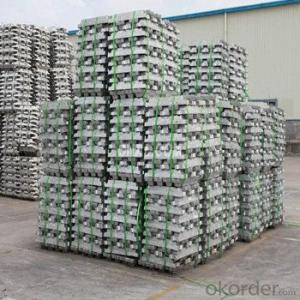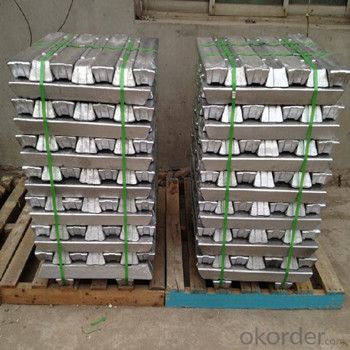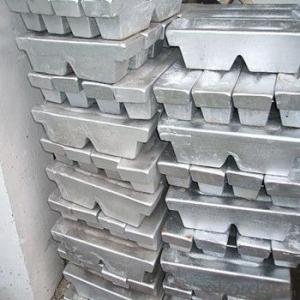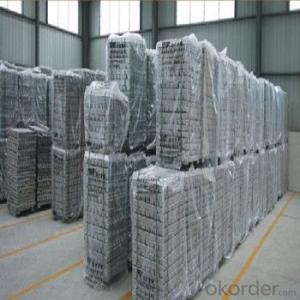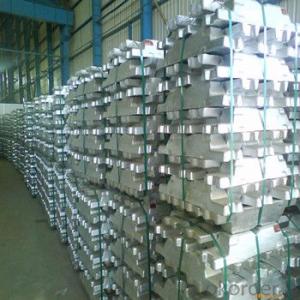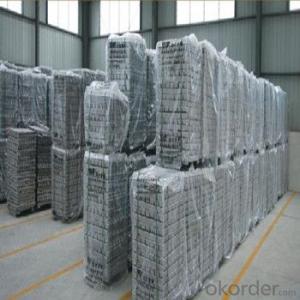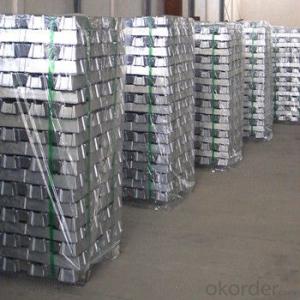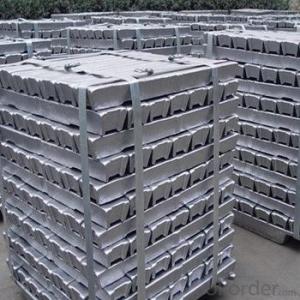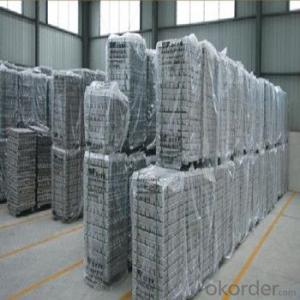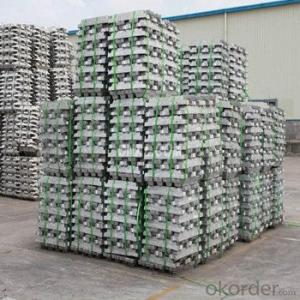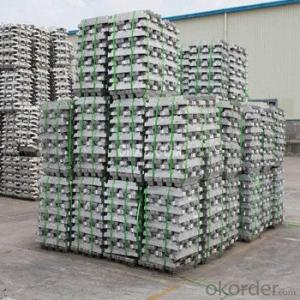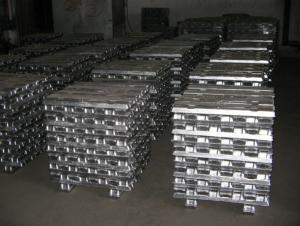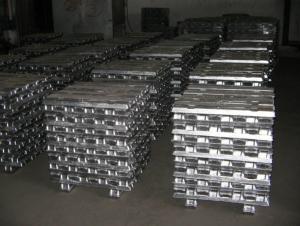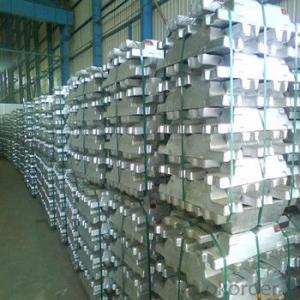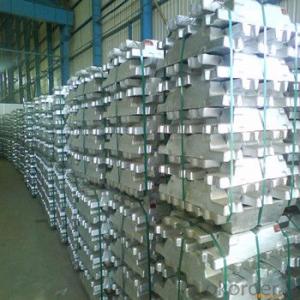Aluminum Ingot With Different Purity For Choice 2015
- Loading Port:
- China main port
- Payment Terms:
- TT OR LC
- Min Order Qty:
- 10000 m.t.
- Supply Capability:
- 100000 m.t./month
OKorder Service Pledge
OKorder Financial Service
You Might Also Like
Pure Aluminum Ingot Used for Industry
1.Structure of Aluminum Ingot Description
A material that has been cast into a shape in order to be transported and processed easier than in an unprocessed form. An ingot is typically rectangular in shape, which allows it to be stacked. Ingots are most commonly associated with metals, with ingots of gold held in the vaults of banks and brokerages being popular images.
2.Main Features of the Aluminum Ingot
•High Purity
•High strength
•Fast melting
•Best price
•Good after-service
3. Aluminum Ingot Images
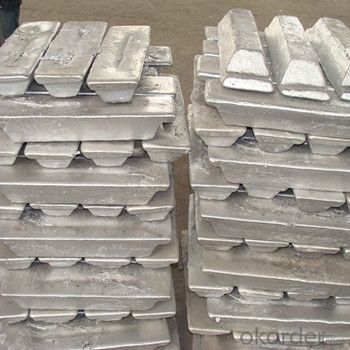
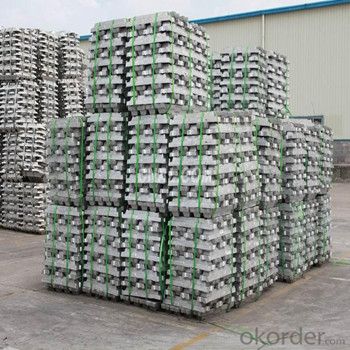
4. Aluminum Ingot Specification
| 500*500*6mm | 500*500*8mm | 1000*500*20mm | 1000*500*15mm |
| 1000*500*8mm | 1000*500*10mm | 1000*500*30mm | 1000*500*6mm |
| 1800*800*20mm | 1800*800*10mm | 2000*1000*20mm | 2000*1000*10mm |
5.FAQ of Aluminum Ingot
We have organized several common questions for our clients,may help you sincerely:
①How about your company?
A world class manufacturer & supplier of castings forging in carbon steel and alloy steel,is one of the large-scale professional investment casting production bases in China,consisting of both casting foundry forging and machining factory. Annually more than 8000 tons Precision casting and forging parts are exported to markets in Europe,America and Japan. OEM casting and forging service available according to customer’s requirements.
②How to guarantee the quality of the products?
We have established the international advanced quality management system,every link from raw material to final product we have strict quality test;We resolutely put an end to unqualified products flowing into the market. At the same time, we will provide necessary follow-up service assurance.
③How long can we receive the product after purchase?
In the purchase of product within three working days, We will arrange the factory delivery as soon as possible. The pecific time of receiving is related to the state and position of customers.Commonly 7 to 10 working days can be served.
- Q: Yl302 aluminum ingot is alumina alloy?
- Aluminum oxide by electrolysis, is the production of aluminum alloy raw materials, aluminum alloy refers to A00 remelting after adding some alloy elements, such as silicon, copper, magnesium, etc., so that the performance has been improved
- Q: The difference between pure aluminium ingot and aluminium alloy ingotToday I know, aluminum ingot is also divided into pure aluminum ingot, aluminum alloy ingot, what is the difference between them?
- Pure aluminium ingot: Aluminum exists in the surface, in addition to iron (Fe) in ranking the second metal elements, since the electrolysis method was invented, human made from bauxite surface, refining of high purity (more than 99.7%) for pure aluminum, aluminum ingots. Such as direct casting for casting toughness is good but not with strength, poor physical properties.
- Q: Brief introduction of die casting aluminium ingot
- Aluminum, our daily industrial raw materials called aluminum ingot, according to the national standard (GB/T1196-93) should be called "remelting with aluminum ingot", but we are used to "aluminum ingot"". It is with the alumina cryolite produced by electrolysis.
- Q: What are the different machining techniques for aluminum ingots?
- Aluminum ingots can be machined using various techniques to achieve different results. Some commonly used techniques include: 1. Turning: To create desired shapes or sizes, a cutting tool is employed to remove material from the surface of the aluminum ingot. This technique is commonly applied to produce cylindrical parts like rods or shafts. 2. Milling: By using a rotating cutting tool, material is removed from the surface of the aluminum ingot to create different shapes and features such as slots, pockets, and complex contours. 3. Drilling: This technique involves the creation of holes in the aluminum ingot using a rotating cutting tool. Holes of various sizes and depths can be achieved through this method. 4. Grinding: An abrasive wheel is utilized in this machining process to eliminate material from the surface of the aluminum ingot. Grinding is commonly employed to attain a smooth and precise surface finish. 5. Boring: To enlarge an existing hole in the aluminum ingot, a single-point cutting tool is used in this machining process. Boring is often used to create holes with larger diameters. 6. Sawing: The aluminum ingot is cut into desired lengths or shapes using a saw blade in this machining technique. Sawing is frequently utilized to divide aluminum ingots into smaller pieces for further processing. 7. Lathing: In this machining technique, the aluminum ingot is rotated while a cutting tool is employed to remove material from its surface. Lathing is commonly used to create symmetrical parts like cones or spheres. These are merely a few examples of the numerous machining techniques available for working with aluminum ingots. The choice of technique depends on the desired shape, size, and surface finish of the final product.
- Q: What is the casting process for aluminum ingots?
- The casting process for aluminum ingots involves several steps to ensure the production of high-quality, uniform ingots. First, the raw aluminum is melted in a furnace at temperatures exceeding 660 degrees Celsius (1220 degrees Fahrenheit). The molten aluminum is then transferred to a holding furnace, where it is maintained at a consistent temperature to prevent solidification. Next, a mold is prepared for casting the aluminum ingots. The mold is typically made of steel or cast iron and is preheated to minimize thermal shock. The mold is also coated with a release agent to prevent the ingot from sticking to the mold. Once the mold is ready, the molten aluminum is poured into it. The pouring process can be done manually or using automated equipment, depending on the scale of production. The molten aluminum fills the mold, taking the shape of the desired ingot. After pouring, the mold is allowed to cool and solidify the aluminum. Cooling time varies depending on the size and thickness of the ingot. As the aluminum cools, it undergoes a phase transformation from liquid to solid, forming a solid ingot. Once the ingot is solidified, it is removed from the mold. This can be achieved by either manually removing the ingot or using mechanical means, such as vibrators or hydraulic presses, to eject the ingot from the mold. Finally, the ingots are typically subjected to further processing, such as heat treatment or surface finishing, to enhance their mechanical properties and appearance. These additional steps may include homogenizing the ingots to ensure uniformity, removing surface defects, or applying protective coatings. Overall, the casting process for aluminum ingots is a complex and precise operation that requires careful control of temperature, mold preparation, and post-processing steps to produce high-quality ingots suitable for further aluminum processing and applications.
- Q: How is aluminum ingot different from aluminum billet?
- Aluminum ingot and aluminum billet are both forms of aluminum metal, but they differ in terms of their shape, size, and manufacturing process. Aluminum ingot is typically produced through a primary aluminum production process called smelting. It is a large rectangular block or slab of solid aluminum with a standardized shape and size. The ingot is usually obtained by casting molten aluminum into a mold and allowing it to cool and solidify. Aluminum ingots are commonly used as raw materials for further processing, such as rolling, extrusion, or forging, to produce various aluminum products. On the other hand, aluminum billet is a semi-finished product that is often derived from aluminum ingots. Billets are usually obtained by heating and continuously casting molten aluminum into a cylindrical shape and then allowing it to cool and solidify. Unlike ingots, billets have a smaller cross-sectional area and a longer length. They are commonly used as starting material for extrusion processes, where they are heated and forced through a die to produce complex shapes like rods, bars, profiles, or tubes. In summary, while both aluminum ingots and aluminum billets are made of the same material, their differences lie in their shape, size, and purpose. Ingots are large rectangular blocks used as raw materials for further processing, while billets are smaller cylindrical shapes used as starting material for extrusion processes.
- Q: What is the lifespan of aluminum ingots?
- The lifespan of aluminum ingots can vary depending on storage conditions, but if properly stored and protected from corrosion, aluminum ingots can last indefinitely.
- Q: What are the global production trends for aluminum ingots?
- The global production trends for aluminum ingots have been increasing steadily over the years. This is mainly due to the growing demand for aluminum in various industries such as automotive, aerospace, construction, and packaging. Additionally, advancements in technology and the push towards sustainable materials have further boosted the production of aluminum ingots.
- Q: How much is a ton of aluminum now?
- According to the surface treatment of different ways, the price difference is much, generally speaking, is the price of aluminum ingot, plus every processing fee, aluminum ingot price is now 13000, plus processing fees in 3500 to 12000 yuan.
- Q: What are the advantages of using aluminum ingots in the production of automotive lightweighting solutions?
- There are numerous benefits associated with the utilization of aluminum ingots in the manufacturing of lightweight automotive solutions. Firstly, aluminum is an incredibly lightweight material, making it ideal for reducing the overall weight of vehicles. Through the use of aluminum ingots, manufacturers are able to significantly decrease the weight of various automotive components, including body panels, engine parts, and structural elements. This reduction in weight results in enhanced fuel efficiency, as vehicles that are lighter require less energy to accelerate and maintain speed. Moreover, it provides improved handling and maneuverability, ultimately enhancing the overall driving experience. Secondly, aluminum possesses exceptional durability and a remarkable strength-to-weight ratio. Despite its lightweight nature, aluminum ingots offer sufficient strength and structural integrity to withstand the demands of everyday driving, ensuring the safety of passengers. Additionally, aluminum is corrosion-resistant, making it a suitable choice for automotive applications exposed to harsh weather conditions or road salt. Another advantage of employing aluminum ingots in automotive lightweighting is their versatility. Aluminum can be easily molded, shaped, and joined using various manufacturing techniques, enabling the production of intricate and complex designs. This versatility allows manufacturers to create innovative automotive components that meet specific performance requirements without compromising weight reduction objectives. Furthermore, aluminum is an environmentally friendly material due to its high recyclability. The recycling process for aluminum consumes minimal energy compared to primary production, resulting in fewer greenhouse gas emissions. This not only aids in reducing the carbon footprint of the automotive industry but also promotes a more sustainable manufacturing process. Lastly, aluminum ingots offer long-term cost advantages. While the initial production costs of aluminum components may be higher compared to traditional materials like steel, the overall lifecycle costs are often lower. The lightweight nature of aluminum reduces the strain on other vehicle systems, such as brakes and suspension, potentially leading to savings in maintenance and replacement expenses. Additionally, the recyclability of aluminum allows for the recovery and reuse of the material, minimizing the need for new raw material extraction. In conclusion, the utilization of aluminum ingots in the production of lightweight automotive solutions offers a range of benefits, including weight reduction, improved fuel efficiency, durability, versatility, environmental friendliness, and long-term cost savings. These advantages position aluminum as the preferred choice for manufacturers seeking to enhance the performance, efficiency, and sustainability of modern vehicles.
Send your message to us
Aluminum Ingot With Different Purity For Choice 2015
- Loading Port:
- China main port
- Payment Terms:
- TT OR LC
- Min Order Qty:
- 10000 m.t.
- Supply Capability:
- 100000 m.t./month
OKorder Service Pledge
OKorder Financial Service
Similar products
Hot products
Hot Searches
Related keywords
